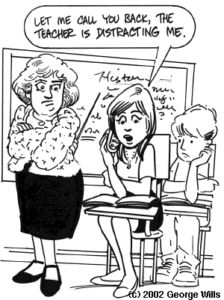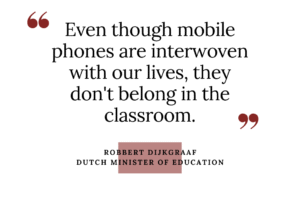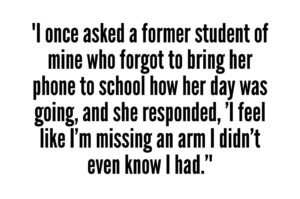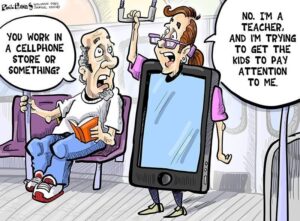This week’s debate topic on whether cell phones should be banned in classrooms prompted a very interesting discussion. Classrooms in Saskatchewan were just coming off a year in which the government implemented a cell phone ban in all Saskatchewan classrooms claiming that it would help students stay more engaged with teachers and more focused on learning. However, this decision came with no consultation with educators and no clear guidelines for how to implement it. Many schools were left scrambling and unsure how to enforce the ban questioning what real impact it would have on student learning.
And now, a year later, I find myself asking and wondering:
- Was the ban actually successful?
- What is the plan moving forward in the fall?
- Has the government shared any data to show whether the ban improved student engagement or learning?
The Debate
The disagree side in this debate argued that phones are a major distraction and negatively affect students’ ability to focus and concentrate. Furthermore, constant access to phones can contribute to mental health concerns, especially anxiety, comparison, and conflict. They emphasized the importance of setting healthy boundaries, suggesting that a phone-free classroom creates a safe zone for learning.
The agree side argued that cell phones are not the problem but misuse is. Sadi emphasized that in today’s Fourth Industrial Revolution, technology is essential, not optional. While acknowledging phones can be distracting, she noted that distractions have always existed and instead called for teaching focus and digital ethics. She also highlighted how phones can be powerful learning tools, supporting creativity, research, and collaboration.
Both sides of the debate offered compelling arguments for and against banning phones, which is why I continue to struggle with where I stand on the issue.
My Experience
This past year, I taught at a school where I had to book Chromebook carts or computer labs to access technology. Prior to that, I taught at a high  school where every student in Grades 9–12 had their own Chromebook. In that environment, there was rarely a need for phones during class, since students already had a device for learning. Because I regularly integrate technology into my lessons, there were many times this year, when students had to use their phones for research, to participate in review games like Kahoot or Blooket, or to complete assignments. The challenge was monitoring cell phone use in my class, while respecting the school’s cell phone rules, such as no phones allowed in the hallway or in bathrooms. t
school where every student in Grades 9–12 had their own Chromebook. In that environment, there was rarely a need for phones during class, since students already had a device for learning. Because I regularly integrate technology into my lessons, there were many times this year, when students had to use their phones for research, to participate in review games like Kahoot or Blooket, or to complete assignments. The challenge was monitoring cell phone use in my class, while respecting the school’s cell phone rules, such as no phones allowed in the hallway or in bathrooms. t
Data and Distractions
To further support the case for a cell phone ban in classrooms, I came across this video, which revealed very interesting results from an experiment a teacher conducted with her class. The teacher asked her class of 30 students, to turn on all of the notifications on their phones, and within the 40-minutes class period, each student was to keep track of every notification they received. After the 40 minutes, they tallied the notifications and the class total was a staggering 662 notifications.
class total was a staggering 662 notifications.
When I hear data like this, it makes me think that maybe we should just get rid of them. Research shows the average teenager spends over seven hours a day on their phone and checks it roughly every 15 minutes. If it takes about 20 minutes for a student to re-engage after each interruption, what impact does that have on learning? How hard does a teacher have to work just to deliver a lesson? In a 60-minute class, how much time is lost telling students to put their phones away, refocusing attention, or repeating what was just said? But is a ban, the right answer?
Yes, Ban!
There is a growing amount of data (and plenty of opinions!) about the effectiveness of full cell phone bans in schools. In a CBC article, experts weighed in on the issue, noting that over the past  decade, as cell phone use has increased significantly, academic performance and student well-being have declined. Studies from countries like Spain, Norway, and Belgium suggest that banning phones can positively impact student achievement. Schools that have implemented school-wide phone bans using tools like magnetic pouches report noticeable improvements in focus, behaviour, and the overall learning environment. These findings suggest that while teaching responsible use has its place, well-implemented cell phone bans may offer a more immediate and measurable way to support student learning and well-being.
decade, as cell phone use has increased significantly, academic performance and student well-being have declined. Studies from countries like Spain, Norway, and Belgium suggest that banning phones can positively impact student achievement. Schools that have implemented school-wide phone bans using tools like magnetic pouches report noticeable improvements in focus, behaviour, and the overall learning environment. These findings suggest that while teaching responsible use has its place, well-implemented cell phone bans may offer a more immediate and measurable way to support student learning and well-being.
No, Ban!

But banning or taking away cell phones is not the solution, according to psychologist Larry Rosen. Rosen argues that a “lack of tech access was proven to be tense, tortuous, and provide clear markers of anxiety.” Instead of banning phones, Rosen suggests that educators focus on retraining students’ attention. For example, he recommends working in 15-minute increments, followed by a one-minute phone check. Furthermore, creating tech-free zones to help students disconnect, and minimizing notifications to reduce distractions are other ways to integrate cell phones in classrooms. Another school principal echoed this approach, stating that they want students to “learn to exist with technology” not without it. Further research indicates that school policies alone are not a silver bullet for preventing the harmful effects of smartphone and social media use. In fact, restrictive policies do not necessarily lead to better outcomes. Instead, a broader focus on addressing overall phone use—both in and out of school—should be the priority.
Inconclusive conclusion.
I really struggle with this topic. Some days I walk into class thinking, “Nope. No phones today.” And then there are days when my students use their phones productively, and I think—maybe the cellphone thing isn’t such a big deal after all. But honestly, navigating the rollercoaster of cellphone use in my classroom is exhausting. The constant monitoring, managing, policing, redirecting, and explaining is relentless. Of all the issues I faced this past year, cellphone use was by far the most time-consuming and the most draining.
While I am fully aware of the negative impact cell phones can have on student learning, I also know my students need to use them when they don’t have access to a school-provided device. And although it might have been easier to implement a total cell phone ban in my classroom, that would have required me to completely change how I deliver certain lessons and activities.

As stated in an Edutopia article, “The toothpaste is out of the tube” and today’s generation is irreversibly enmeshed in technology, and teachers must rethink, adapt, and evolve their approach to cell phone use in the classroom. From setting clear expectations and consistent consequences, to intentionally incorporating phones into lesson planning, to educating students about how cell phone use impacts learning, all of these strategies can support teachers as they navigate this ongoing challenge.
In the end, there’s no single right answer. We, as educators, are doing our best to make decisions we believe are in the best interest of our students. Whether we are navigating the challenges of a school-wide cell phone ban or managing phone use in our own classrooms, the reality is that cell phones are here to stay. That is why we must continue having meaningful discussions about the issue to ensure we are doing what is truly in the best interest of our students.

9 Comments
Jessalyn Shwaga
Hi Leanne,
I really enjoyed your perspective on this topic, especially as a teacher who has only interacted with young kids. What you said about it being exhausting resonates with me. Technology as a whole can be tiresome as a teacher. It’s not so much cellphones in my classroom but Chromebooks. I feel like when I give them assignments to work on that requires a Chromebook I spent 80% of the time making sure they’re doing what they’re supposed to be doing, another 10% fixing problems, and only 10% actually walking around and helping students who need help. By the time their assignment is done and they hand it in it’s like I have to send half of them back to redo it because they missed the point or put in a bare minimum effort because they were so eager to get done so they could ask for free time to play games on their Chromebook. If this is how my students feel about devices that aren’t even theirs, I can’t imagine how much more distracting their personal devices would be. However, your analogy is so accurate, the toothpaste is out of the tube, and that quote from the student you included comparing their phone to living with a missing arm is unfortunately very accurate. Having students refocus is a genuine issue I noticed with my grade 6s and my 9s. The one concern I have with not implementing a ban is that it then becomes our job as teachers to teach a parent responsibility: how to properly use cellphones. I struggle to get through the curriculum as is and I’ve been commended by my administrators and superintendent on how well planned I am. I just do not know how I am supposed to add teaching cellphone literacy to my students as well. Is this something you have found in your classroom?
Leanne Meili
Hi Jessalyn,
Yes! I feel your struggle! This past year, I often found myself questioning my ability to effectively manage classroom distractions—especially those caused by cell phones. What I needed to figure out, is what worked for me so that I could teach. I flipflopped all year and tried different things and yes it was exhausting but it was also exhausting to try and teach without technology. For me, teaching cellphone literacy involved a lot of reminders, when they were actually allowed to use their phones and enforcing consequences when they were misused. I believe the goal should be (and I need to be better at this!) to figure out how to incorporate cellphone/digital literacy into my lessons instead of thinking of it as something extra I have to do. Maybe that’s why technology/cell phone integration and management feels so challenging- because its not something woven seamlessly into our learning environments and because we don’t have sufficient support in how to do this. Does your staff discuss how to incorporate digital/cell phone literacy? Do you have the opportunity to share your struggles and have discussions about this issue?
Kritika Sehgal
Hi Leanne,
I really enjoyed reading your honest reflection on the cellphone ban debate. Your experience juggling the challenges of monitoring phones while trying to keep students engaged really resonated with me. It’s clear that the lack of clear guidelines in Saskatchewan made things harder for teachers, and your question about the real impact of the ban is so important. I found myself wondering that too!
The notification experiment you shared was eye-opening. 662 distractions in just 40 minutes is a crazy number! That really shows how tough it must be for students to stay focused, and how much time teachers lose refocusing the class.
I also appreciate how you presented both sides fairly, sharing research that supports banning phones, but also highlighting expert opinions that focus on helping students learn to manage their attention with phones instead of banning them outright. That balanced view helps me understand why there’s no easy solution here.
One thing that might make your post even stronger is if you added a few specific examples of how you’ve personally handled phone use in your classroom. Maybe some strategies that worked or didn’t work for you? That could give readers practical ideas to think about alongside the bigger debate.
Thanks for sharing your thoughtful insights.
Kritika
Dustin Hubick
Thanks for the balanced overview of the issue. Inconclusive is often where I find myself, a habitual fence sitter. I appreciate your notes on using interactive and engaging sites like Kahoot that work well with handheld devices. Through my own interests and university courses, I have found many intriguing sites and apps that I like to use to engage students. The ban was a bit of a gut punch in the sense that some of that had to go away or be tailored solely to Chromebooks (when available). Something I struggle with is the policing due to the ban. It is one thing to have to police my policy, one that would be created with student input. However, policing a government policy, one without real discussion or collaboration from stakeholders, with difficult. In a way, I kind of found out what it was like to be a student, living under a forced policy. I am intrigued by the work of Larry Rosen now that you shared his perspective.
Jenna Reimer-Jones
Hi Leanne,
It is surprising that educators were not consulted about banning cell phones. It is always interesting when the people most affected by a decision are not included in the process. You make great points about both sides of the debate. I wonder if time will reveal the right answer, but I agree that conversations like these are necessary to find a solution or at least “best practice.” It must be frustrating to have to implement policies without having had any input. I particularly liked your initial questions, especially regarding the data to show whether the ban improved student learning. That information would be essential. Decisions should have evidence to support them and explain why they are being implemented.
Jenna
Jenni Peeke
That phone experiment sounds like it would be an interesting one to use in a lesson for students — let them see just how many distractions we face in a day with notifications turned on! Last month I watched a livestream from Dr. Jody Carrington which was accurately titled “How to Deal with Assholeryish People.” In it she talked a lot about loneliness and the overwhelm of noise. Some stats she presented included that over 50% of people report feeling isolated and unseen… the average office worker is interrupted every 11 minutes, and that many people check their phones 50+ times a day, leading to fragmented focus and dysregulation.
Those stats make me think that everyone should take some time out of their day to shut the phones off.
On the flipside, I was in a high school last year and between classes all I could see in the halls and bathrooms was students intensely staring at their phones. It honestly made me think of someone with an addiction being given their “fix.” It didn’t seem to help with the dysregulation and lack of connection at all.
This is such a tough topic!
Thanks for the great read 🙂
Leanne Meili
Very interesting, Jenni!
I never thought that I was someone addicted to my phone, but lately if I have misplaced it for even 5 minutes, I am ready to snap! Wow! I definitely need to do a detox! In terms of connection- we think we are connected to people because of our phones- but sadly this is not the case. With an increase in mental health issues/concerns, how do we balance phone use with authentic connection? I feel this could be a topic for an entire class!
Kaela
Wow! 662 notifications! That really puts things into perspective. Your post was such a relatable reflection on the constant noise that tech brings into our lives. I especially appreciated your line about how the “inconclusive conclusion” might actually be the most realistic one; because the impact of technology isn’t black and white, especially in education.
I shared a similar sense of being caught in the middle, recognizing all the incredible ways tech can support learning, but also seeing how it can quickly become a distraction or even a burden. I’ve found that with the recent phone ban in Saskatchewan classrooms, students are still on their devices… just more secretively. So, like you said, the problem isn’t always the device itself- it’s how we use it, and how we help students navigate that use mindfully.
Thanks for sharing! 🙂
Hugh Belle
The examples made it more relatable. The way you explained the topic was very clear. I still have a question about one part.